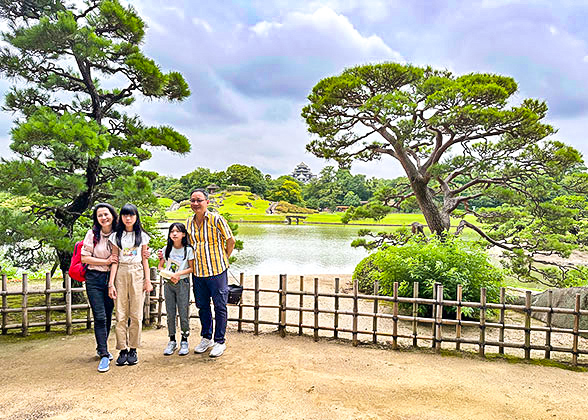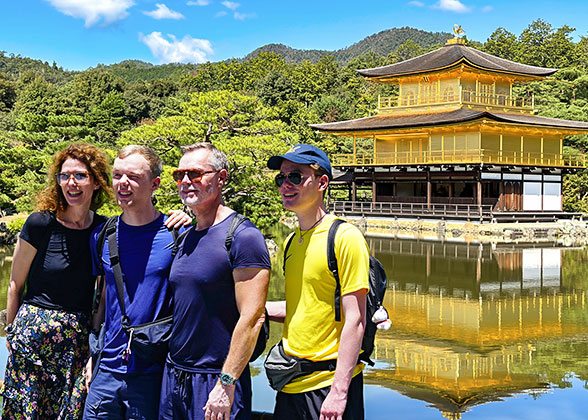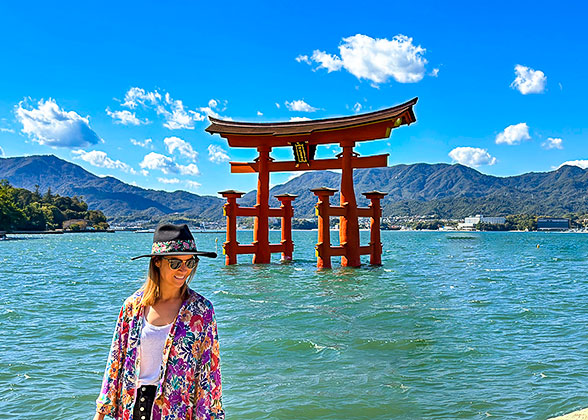Korakuen Garden

Visitors in Korakuen Garden
|
Unlike other Japanese gardens, Korakuen Garden is the first to plant a large area of lawn, while other Japanese gardens use moss to accentuate their designs. In the Korakuen Garden, visitors can enjoy the natural scenery while also learning about the history and culture of Japan through ancient architecture.
Attractions You can Visit in Korakuen Garden
1. En’yō-tei House

En’yō-tei House in Korakuen Garden
|
2. Nō Theater Stage
Nō Theater Stage was built by the Nō opera lover Kosei Ikeda, a feudal lord in the early Edo period, mainly for watching Nō opera performances and receiving guests. Now, you can see some valuable Nō opera clothes on display here.3. Renchi-ken Rest House
The Renchi-ken Rest House is built facing the pond. From the interior, you can enjoy the most beautiful views of the garden, including the wooden bridge across the pond and the pine forest on the opposite bank. It is also one of the a few precious buildings that survived the war and still retains the style of the past.4. Yuishinzan Hill

Yuishinzan Hill in Korakuen Garden
|
5. Crane Aviary
Here, you can see the elegant and noble cranes. Currently, eight red-crowned cranes are bred in the garden. On New Year's Day, to celebrate the festival, staff will release the cranes from their cages and let them move freely in the garden.6. Jigen-dō Temple
Jigen-dō Temple was built in 1697 to pray for the peace of the clan and to bless the people with safety. There are two gods guarding the hall. Within the hall lies a rock, piled up with 36 pieces of granite, resembling the formal black hat donned by ancient Japanese men upon reaching adulthood.
|
|
|
Seasonal Scenery in Korakuen Garden
1. Plum Blossoms and Cherry Blossoms in Spring
The Plum Grove was formed around the end of the Edo period. From late February to mid-March, the 100 plum trees are blooming with delicate white and pink flowers.Cherry Blossom Tree Grove boasts over 300 cherry blossom trees, making it one of Japan's most famous cherry blossom viewing spots. The best time to view cherry blossoms is from late March to early April.
2. Lotus Flowers in Summer
July to August is the season when the lotus flowers in Korakuen Garden are in full bloom. At this special time, tourists will be able to see different kinds of lotus flowers, especially the Ōga lotus, a particularly large pink lotus. Every year, on the first Sunday of July, special activities will be held in the garden from 4 a.m. to 8 a.m., to celebrate the Lotus Viewing Festival.
|
|
|
3. Red Maple Leaves and Chrysanthemum Flowers in Autumn
The Chishio-no-mori Grove contains 100 maple trees that bud in the spring and turn red in the fall, like a sunset. For many years, it has been the most popular attraction in Korakuen Garden in autumn.The Okayama Prefecture Chrysanthemum Convention is held from late October to mid-November every year. At the exhibition, 450 chrysanthemums in various colors grown by chrysanthemum lovers in this prefecture are displayed, such as Japanese large chrysanthemums, cliff chrysanthemums and small chrysanthemums.
Featured Activities You can Experience in Korakuen Garden
1. Yōsai Tea Ceremony
Korakuen Garden in Okayama
2. Early Spring Festival
From January 1st to 3rd every year, there are many New Year activities in Korakuen Garden. During this period, tourists are able to relish a variety of magnificent scenes within the park as well as special activities, such as koto performances. During the 3 days, Korakuen Garden are open for free.How to Get to Korakuen Garden
When can I Enter Korakuen Garden?
March 20th - September 30th: 7:30 a.m. - 6:00 p.m., last admission at 5:45 p.m.October 1st - March 19th: 8:00 a.m. - 5:00 p.m., last admission at 4:45 p.m.
Tickets:
|
Tickets |
Individual tickets |
Tickets for groups with 20 or more members |
| Adults |
JPY500 |
JPY400 |
|
Children below and at 14 years old |
free |
free |
|
Seniors over 65 |
JPY200 |
JPY160 |
|
Joint tickets |
Korakuen Garden + Okayama Prefectural Museum of Art |
JPY600 |
|
Korakuen Garden + Okayama Castle |
JPY720 |
|
|
Korakuen Garden + Okayama Castle + Hayashibara Museum of Art |
JPY1,120 |
Recommended Touring Times
The area of Korakuen Garden is not very large, and it takes about one and a half hours to visit the whole garden.Nearby Attractions
1. Okayama Castle
Okayama Castle and Korakuen Garden are separated only by the Asashi River, so it only takes a few minutes to walk to Okayama Castle from Korakuen Garden. Okayama Castle, also known as "Black Castle" for its black appearance, is one of the oldest castles in Japan and was once the residence and office of the feudal lord. You can purchase a joint ticket for Okayama Castle and Korakuen Garden and visit them together.2. Okayama Prefectural Museum of Art
The Okayama Prefectural Museum of Art is nearby the entrance to Korakuen Garden. Opened in August 1971, it focuses on the history and cultural changes of Okayama Prefecture, and houses some of Japan's national treasures.3. Hayashibara Museum of Art
The Hayashibara Museum of Art is located southwest of Okayama Castle and houses some of the swords and paintings used by the former Okayama Castle master Ikeda's family, as well as the paintings collected from Okayama industrialist Ichiro Hayabara (1908-1961).
You May Like
-
 7 Days Best Private Tour in Japan to Tokyo - Mt. Fuji - Tokyo - Kyoto - Nara - Osaka from USD2401
7 Days Best Private Tour in Japan to Tokyo - Mt. Fuji - Tokyo - Kyoto - Nara - Osaka from USD2401 -
 8 Days Mini Group Tour: Tokyo - Hakone & Mt. Fuji - Kyoto - Nara - Osaka - Hiroshima - Osaka from USD2771
8 Days Mini Group Tour: Tokyo - Hakone & Mt. Fuji - Kyoto - Nara - Osaka - Hiroshima - Osaka from USD2771 -
 7 Days Mini Group Tour with Essence of Japan: Tokyo - Mt. Fuji - Kyoto - Nara - Osaka from USD2155
7 Days Mini Group Tour with Essence of Japan: Tokyo - Mt. Fuji - Kyoto - Nara - Osaka from USD2155


